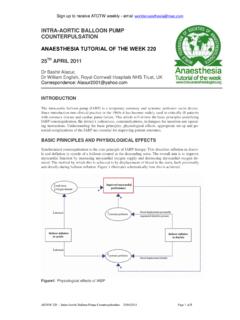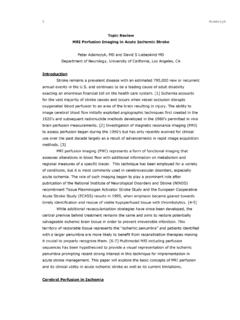Transcription of SpontaneouS CerViCal artery DiSSeCtion - SciELO
1 Arq Neuropsiquiatr 2008;66(4):922-927922 Views and reviewsSpontaneouS CerViCal artery DiSSeCtionAn update on clinical and diagnostic aspectsCynthia Resende Campos-Herrera1, Milberto Scaff2, F bio Iuji Yamamoto2, Adriana Bastos Conforto2 Abstract SpontaneouS CerViCal arterial DiSSeCtion (SCAD) is a non-traumatic tear or disruption in the wall of the internal carotid arteries or the vertebral arteries. It accounts for about 25% of strokes in patients aged under 45 years. Awareness of its clinical features and advances in imaging over the last two decades have contributed to earlier identification of this condition.
2 SCAD has become the commonest form of vascular lesion identified in the CerViCal carotid and vertebral arteries, second only to atherosclerosis. This review is an update on the epidemiology, vulnerable arterial segments, risk factors, clinical features, diagnosis, current treatment and prognosis of SCAD. Key worDS: DiSSeCtion , carotid, vertebral artery , stroke, o espont nea da art ria CerViCal : atualiza o sobre aspectos cl nicos e diagn sticosResumo Dissec o arterial CerViCal espont nea (DACe) uma lacera o ou ruptura na parede de art rias cervicais respons veis pela irriga o sangu nea cerebral: art rias car tidas internas e art rias vertebrais.
3 Respons vel por cerca de 25% dos acidentes vasculares cerebrais isqu micos em pacientes abaixo de 45 anos de idade. Ao longo das duas ltimas d cadas, com a maior conscientiza o sobre suas manifesta es cl nicas e o avan o das t cnicas de neuroimagem, a DACe tem sido diagnosticada mais precocemente, tornando-se o tipo de les o vascular mais comumente identificado nas art rias cervicais, sendo superada apenas pelas les es ateroscler ticas. esta revis o uma atualiza o sobre a epidemiologia, segmentos arteriais mais vulner veis, fatores de risco, manifesta es cl nicas, diagn stico, tratamento e progn stico da : dissec o, art ria vertebral, acidente vascular cerebral, ; Municipal hospital M rio Gatti, Campinas, SP, Former Post-Graduation student (PhD) of the Department of Neurology of the Faculty of Medicine of the University of S o Paulo, S o Paulo SP, Brazil (USP).
4 2 Neurologists, Division of Neurology, hospital of Clinics, 3 September 2008. Accepted 5 october Adriana Bastos Conforto - Avenida Dr. En as de Carvalho Aguiar 255/5084 - 05403-000 S o Paulo SP - Brasil. E-mail addresses: CerViCal arterial DiSSeCtion (SCAD) is a non-traumatic tear or disruption in the wall of the brain-supplying arteries: the internal carotid artery (ICA) and the vertebral artery (vA)1,2. The DiSSeCtion leads to ac-cumulation of blood within the layers of the artery , be-tween the intima and the media (subintimal DiSSeCtion ) or between the media and the adventitia (subadventitial DiSSeCtion ), resulting in an intramural hematoma that can spread along the vessel proximally and distally2.
5 The in-tramural hematoma can cause stenosis or occlusion of the vessel lumen. The anatomic disruption of the endo-thelium in subintimal dissections or impaired blood flow due to the narrowing of the lumen predispose to local thrombus formation which can either occlude the vessel or embolize distally resulting in brain infarction or eye ischemia3,4. Subadventitial dissections lead to formation of aneurysms and, if the DiSSeCtion spreads intracranially, to subarachnoid hemorrhage1,2. Neurological focal deficits can occur either because of artery -to- artery emboliza-tion of the intraluminal thrombus, or by an hemodynam-ic mechanism, with subsequent reduced perfusion in the brain territory supplied by the stenosed artery2,5,6.
6 The first clear case of SCAD a patient with a spon-taneous dissecting aneurysm of the internal carotid ar-tery (ICA) was described in 19597,8. But it was the work of Fisher et al. in the late 1970s that led to the recogni-tion of the clinical and radiological features of DiSSeCtion syndromes facilitating their antemortem diagnosis9. over the last two decades, as awareness of its clinical features increased, and with advances in imaging, SCAD has been identified increasingly earlier, becoming the commonest form of vascular lesion identified in the CerViCal carot-id and vertebral arteries, second only to review is an update on the epidemiology, vulner-Arq Neuropsiquiatr 2008.
7 66(4) 923 SpontaneouS CerViCal artery dissectionCampos-herrera et arterial segments, risk factors, clinical features, diag-nosis, current treatment and prognosis of SCAD. epiDemiologySCAD accounts for about 25% of strokes in patients under 45 years old10,11. The annual incidence is estimated to be to 5 per 10000012,13. The incidence of ICA dissec-tion is approximately two times higher than the incidence of vA dissection11. Simultaneous multivessel dissections may occur in up to 30% of the cases14,15. SCAD may affect all age groups, but there is a distinct peak in the fifth decade of life12,14.
8 There is no clear gender predominance, but it occurs approximately five years earli-er in women than it does in men13. In Brazil, two case-series studies on SCAD were published based on the clinical ex-perience of three tertiary health care centers and showed demographic findings similar to the international series16,17. Vulnerable arterial SegmentSThe most common locations of SCAD are regions where the arteries are more mobile and not firmly an-chored to other arteries or bony structures1,2, ICA is relatively fixed proximally, at the origin from the common carotid artery , and distally, at the point of penetration in the petrous portion of the temporal bone.
9 The arterial segment between these two points of anchor-age is mobile and therefore vulnerable to stretching, es-pecially during neck hyperextension with head rotation, which can stretch the ICA against an upper CerViCal verte-bra or a proeminent styloid process1,2. The tear often oc-curs around 3 cm above the carotid bifurcation2, extracranial vA is anchored at its origin from the subclavian artery (v1 segment), during its course through the spine within the intervertebral foramina (v2 segment), and by the dura at the point of intracranial penetration.
10 The v1 segment is vulnerable to DiSSeCtion , usually be-ginning above the origin from the subclavian artery . It is relatively fixed at the bony orifice of the C6 interverte-bral foramen but the increased mobility at C5-C6 level makes it vulnerable to stretching18. The short segments between the intervertebral foramina in the v2 segment are also common sites of DiSSeCtion , as they are vulnera-ble to longitudinal stretching2,18,19. The rotation in the at-lantoaxial joint and the flexion and extension in the at-lanto-occipital joint increases risk of stretching at v3 seg-ment18,19.













